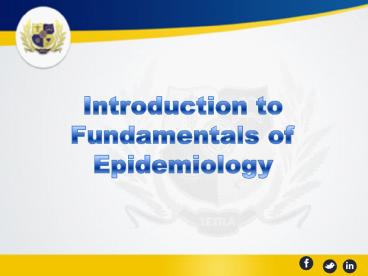Introduction to Fundamentals of Epidemiology (1) - PowerPoint PPT Presentation
Title:
Introduction to Fundamentals of Epidemiology (1)
Description:
Epidemiology is a study of public health science that helps to identiy and analyse the diseases in human population and to identy the risk factors. Read more: – PowerPoint PPT presentation
Number of Views:118
Title: Introduction to Fundamentals of Epidemiology (1)
1
Introduction to Fundamentals of Epidemiology
2
Scope of Epidemiology
- The scope of Epidemiology Program is to
- To describe analyze occurrence of diseases in
human population - To study natural history and prognosis of
health-related problems - To identify causes and risk factors
3
What is Epidemiology?
Epidemiology is the Study of the occurrence
distribution of health-related diseases or events
in specified populations, including the study of
the determinants influencing such states, and the
application of this knowledge to control the
health problem. (Last JM ed. Dictionary of
Epidemiology, Oxford University Press, 1995)
4
Components of Epidemiology
- Disease Frequency The core characteristics of
epidemiology - are to measure the frequency of diseases,
disability or death - Distribution of Diseases Based on time, place
person, epidemiology tenets help to
identify if a specific disease has
increased or decreased in the community - Determinants of Diseases Identifying the major
agents for or causes of diseases
5
Basic Principles of Epidemiology
- Time
- When did the event happen?
- Place
- Where did the event happen?
- Person
- Who was affected?
6
Uses of Epidemiology
- Epidemiology can be implemented in different
verticals - Public Health Surveillance - Examine causation
- Field Investigation
- Analytic Studies - Description of the health
status of population - Evaluation of Different Diseases - Determine the
relative importance of causes of illness,
disability and deathHealthcare - Policy Development - Identifying risk factors
7
Crucial Role of Epidemiology
- Epidemiology is crucial during Disasters
Response - To collect and analyze the health related data in
affected community in order to guide the
decision-makers to guide a rational responds
Change Lives, Build a Healthier World - Public
Health Programs
8
Clinician vs. Epidemiologist Job Prospects
- Clinician
- Deals with patients
- Takes a history
- Conducts a physical investigation
- Makes a diagnosis
- Proposes a treatment
- Epidemiologist
- Deals with population
- Frames the question
- Investigates
- Draws conclusions
- Gives recommendations
- Evaluates programmes
9
Study Natural History
Death
Sub-clinical disease
Clinical disease
Good health
Recovery
10
Description of health status of population
Prevalence of anemia among adolescent girls,
Mandla, MP, India 2005
Age in years Hemoglobin lt12 g Hemoglobin lt12 g Total
Age in years Number () Total
12-13 71 93.4 76
14-15 88 93.6 94
16-17 71 97.3 73
Total 230 93.8 243
11
Determine relative importance of causes of
illness, disability death
Disease DALYs (000) Mortality (000)
Tuberculosis 7577 421
Measles 6471 190
Malaria 577 20
12
Evaluation of Interventions
Good Health
Ill Health
Health promotion Preventive measures Public
health services
13
Epidemiological Approaches
- Descriptive epidemiology
- What is the problem?
- Where When does the problem occurs?
- Analytical epidemiology
- Attempts to analyze the causes or determinants of
disease - Intervention or experimental epidemiology
- Clinical or community trials to answer questions
about effectiveness of control measures
Interested to Study Epidemiology ? Get Started
Now !
14
Measures of disease frequency
- Prevalence
- Number of cases of a disease in a defined
population at specified point of time - Incidence
- Number of new cases, episodes or events occurring
over a defined period of time
15
Study Public Health Programs Online Want to
Know How ?
Speak to our Enrollment Advisor Today!

























![book❤️[READ]✔️ Equine Internal Medicine 4th Edition PowerPoint PPT Presentation](https://s3.amazonaws.com/images.powershow.com/10074326.th0.jpg?_=20240708013)
![book❤️[READ]✔️ Equine Internal Medicine 4th Edition PowerPoint PPT Presentation](https://s3.amazonaws.com/images.powershow.com/10074295.th0.jpg?_=20240708010)




